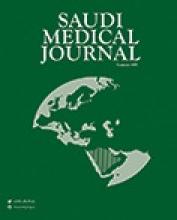Abstract
OBJECTIVE: To determine the frequency of diabetic patients who attained the optimal postprandial blood glucose level.
METHODS: Cross-sectional study of type-2 diabetic patients being followed at the medical outpatient clinic of King Abdul-Aziz University Hospital, Jeddah, Kingdom of Saudi Arabia, from January 1999 to December 2001. Patients were classified according to postprandial blood glucose level into 3-categories; group-1 (<9mmol/l), group-2 (9.1-10 mmol/l), group-3 (>10 mmol/l). Other data such as age, sex, duration of diabetes, presence of hypertension, hyperlipidemia, smoking, obesity, ischemic heart disease was recorded as well as mortality.
RESULTS: A total of 443 patients were studied with mean age of 55 years and equal male to female ratio. The mean 2-hour postprandial blood glucose level was 14 mmol/l. The majority of patients were in group-3 (71%), while group-1 was 22% and group-2 was 7%. Patients with high 2-hour postprandial blood glucose (group-3) have a higher prevalence of hypertension [120/315 (38%) versus 31/97 (32%) p=0.01], hyperlipidemia [72/315 (23%) versus 13/97 (13%) p=0.02], obesity [79/315 (25%) versus 18/97 (19%) p=0.04], ischemic heart disease [72/315 (23%) versus 16/97 (17%) p=0.04] and mortality [35/315 (11%) versus 8/97 (8%) p=0.06] compared to those with controlled level (group-1).
CONCLUSION: A low frequency of diabetics attained the optimal 2-hour postprandial blood glucose level. Action should be taken on this crucial issue for the optimal management of diabetes.
- Copyright: © Saudi Medical Journal
This is an open-access article distributed under the terms of the Creative Commons Attribution-Noncommercial-Share Alike 3.0 Unported, which permits unrestricted use, distribution, and reproduction in any medium, provided the original work is properly cited.






